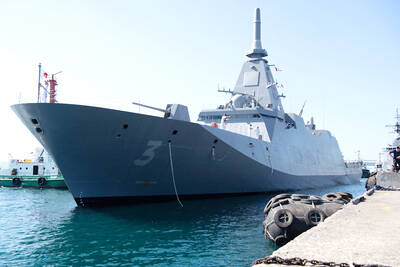Pakistani commandos dropped into a key Taliban stronghold in the Swat valley yesterday, stepping up a punishing offensive against militants that has displaced more than 360,000 people.
Troops opened up a new front in the district’s northern mountains, the suspected stronghold of firebrand Taliban commander Maulana Fazlullah and his top lieutenants behind a nearly two-year uprising that has devastated the area.
Military officials said “heliborne troops” landed at Peochar, about 65km northwest of the main Swat town of Mingora, in the first such assault during the latest offensive to crush the Taliban in the district.

PHOTO: AP
“The operation is right now in progress,” one of the officials said from the northwest region.
Attack helicopters also shelled suspected Taliban hideouts in Malam Jabba, once frequented for its pristine winter ski slopes, a military official said.
Pakistani ground and air forces have been pounding Taliban strongholds across the northwest for 16 days in what Islamabad says is a fight to eliminate militant — branded by Washington as the greatest terror threat to the West.
Military officials have released death tolls that combine to more than 780 dead militants but are not independently verifiable.
Rights groups have called on Pakistan to avoid civilian casualties and local doctors who have fled the onslaught say Swat’s main hospital is closed and that the wounded cannot be treated with no electricity.
“Beheadings and use of human shields by Taliban forces are not a blank check for the Pakistani army,” Human Rights Watch Asia division director Brad Adams said.
“Winning the war but also the peace in Swat can only be achieved by minimizing civilian suffering,” Adams said.
The US-based group said it received reports of civilian deaths and destruction of property in the aerial bombardment, but that because the area was a closed military zone it was impossible to verify the information.
It also quoted reports from those fleeing that the Taliban had mined parts of the valley and were preventing people from leaving — “effectively using the people there as human shields to deter military attack.”
The military has relied heavily on helicopter gunships, fighter jets and artillery during the offensive, which critics argue will maximize the risk of collateral damage.
Ahmad Ali, 24, said by telephone that armed Taliban were prowling the streets of Mingora.
“I’ve never even a single soldier during curfew hours in the city and only armed Taliban are seen patrolling streets,” he said. “Taliban fire mortars on security forces from heavy guns.”
The military said last week that between 12,000 and 15,000 security forces were operating against 4,000 well-armed Taliban fighters in Swat, once a ski resort popular with Westerners but ravaged by the advancing Taliban menace.
Security officials said Pakistani troops killed eight militants in Lower Dir district, where troops were using helicopter gunships and artillery yesterday.
It is difficult for reliable and independent information on developments to filter across the frontlines, as many local journalists have reportedly fled.
The UN refugee agency said more than 360,000 displaced people had registered after escaping the worst-affected districts of Buner, Lower Dir and Swat, although the UN feared the numbers could be much higher.
“This is a huge and rapidly unfolding emergency, which is going to require considerable resources beyond those that currently exist in the region,” UN High Commissioner for Refugees Antonio Guterres said.
The agency was to begin an airlift Tuesday ferrying 120 tonnes of supplies.

Eleven people, including a former minister, were arrested in Serbia on Friday over a train station disaster in which 16 people died. The concrete canopy of the newly renovated station in the northern city of Novi Sad collapsed on Nov. 1, 2024 in a disaster widely blamed on corruption and poor oversight. It sparked a wave of student-led protests and led to the resignation of then-Serbian prime minister Milos Vucevic and the fall of his government. The public prosecutor’s office in Novi Sad opened an investigation into the accident and deaths. In February, the public prosecutor’s office for organized crime opened another probe into

RISING RACISM: A Japanese group called on China to assure safety in the country, while the Chinese embassy in Tokyo urged action against a ‘surge in xenophobia’ A Japanese woman living in China was attacked and injured by a man in a subway station in Suzhou, China, Japanese media said, hours after two Chinese men were seriously injured in violence in Tokyo. The attacks on Thursday raised concern about xenophobic sentiment in China and Japan that have been blamed for assaults in both countries. It was the third attack involving Japanese living in China since last year. In the two previous cases in China, Chinese authorities have insisted they were isolated incidents. Japanese broadcaster NHK did not identify the woman injured in Suzhou by name, but, citing the Japanese

YELLOW SHIRTS: Many protesters were associated with pro-royalist groups that had previously supported the ouster of Paetongtarn’s father, Thaksin, in 2006 Protesters rallied on Saturday in the Thai capital to demand the resignation of court-suspended Thai Prime Minister Paetongtarn Shinawatra and in support of the armed forces following a violent border dispute with Cambodia that killed more than three dozen people and displaced more than 260,000. Gathered at Bangkok’s Victory Monument despite soaring temperatures, many sang patriotic songs and listened to speeches denouncing Paetongtarn and her father, former Thai prime minister Thaksin Shinawatra, and voiced their backing of the country’s army, which has always retained substantial power in the Southeast Asian country. Police said there were about 2,000 protesters by mid-afternoon, although

MOGAMI-CLASS FRIGATES: The deal is a ‘big step toward elevating national security cooperation with Australia, which is our special strategic partner,’ a Japanese official said Australia is to upgrade its navy with 11 Mogami-class frigates built by Japan’s Mitsubishi Heavy Industries, Australian Minister for Defence Richard Marles said yesterday. Billed as Japan’s biggest defense export deal since World War II, Australia is to pay US$6 billion over the next 10 years to acquire the fleet of stealth frigates. Australia is in the midst of a major military restructure, bolstering its navy with long-range firepower in an effort to deter China. It is striving to expand its fleet of major warships from 11 to 26 over the next decade. “This is clearly the biggest defense-industry agreement that has ever